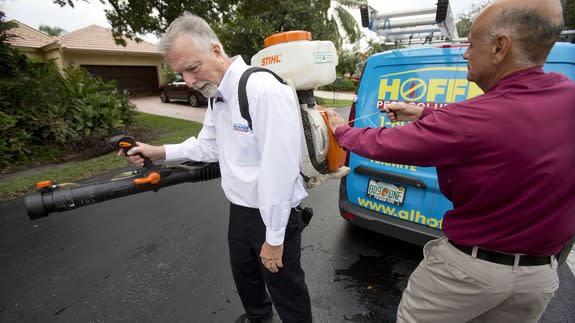Risk of a U.S. Zika virus outbreak may be highest in southern Texas and South Florida

Cities in southern Florida and southern Texas, including Houston, Miami and Orlando, are at greater risk of seeing a Zika virus outbreak in the coming summer months compared to more northerly locations in the U.S., according to a new study.
However, there is some risk of an outbreak even in cities in the Mid-Atlantic, including New York City, Philadelphia and Washington, and as far west as Los Angeles, the study found.

Image: NCAR
The research, which is published in the journal PLOS Currents: Outbreaks, examines several factors related to the spread of the Zika virus, including the seasonal abundance of the Aedes aegypti mosquito, which transmits Zika, in 50 cities within or near the mosquito's known range.
The study found that while a large portion of the country shows a seasonal susceptibility to Zika virus outbreaks, the southern reaches of the nation lie at the intersection of high seasonal suitability for the Aedes mosquito along with abundant direct flight connections to Latin America, which increases the odds of travel-related virus introduction.
The study focuses on the meteorological variables that influence the Aedes mosquito as well as travel and socioeconomic factors, and is aimed at guiding mosquito control measures and assisting public health authorities in anticipating and planning for Zika.
“For most people in the U.S. there is zero risk right now in the middle of March and the end of winter, because it’s cold,” said lead author Andrew Monaghan of the National Center for Atmospheric Research in Boulder, Colorado, in an interview.
"As you move into summer, you do have more climatic suitability in the U.S.,” Monaghan said.

Image: National Center for atmospheric research.
Aedes mosquitoes have difficulty surviving winter in northern areas, which explains why they are more abundant in milder regions of the U.S.
The ongoing Zika virus pandemic continues to spread throughout Central and South America, with the wave of the disease lapping against the U.S. Nearly 200 travel-related cases of the virus have been recorded in the U.S. so far, and many more are expected.
The Centers for Disease Control and Prevention (CDC) has warned that limited local outbreaks of Zika are possible this summer, particularly in parts of the South.
Neither the CDC, nor the authors of this new study, are trying to predict the timing or exact location of the virus' emergence in the U.S., in part because there is so much that experts don't know about Zika.
This includes how long of a period there is between when a mosquito bites someone infected with Zika to when that same mosquito is capable of spreading the virus to someone else through its saliva.
"I think it’s a very dangerous game to play with trying to predict disease emergence,” said NCAR scientist Mary Hayden, a medical anthropologist and co-author of the study, in an interview.
Social and economic factors make a large-scale Zika outbreak relatively unlikely in U.S. cities compared to Latin America, since a higher percentage of Americans live and work in air conditioned homes and offices.
The researchers used computer models to simulate the effect of meteorological conditions on a mosquito’s entire lifecycle, from the egg to adult stages, in 50 cities in or near the known range of the species.
The study found that conditions become most suitable for Aedes mosquito populations in the summer and early fall months of July, August and September, although western and southern cities can remain suitable through November.
Monaghan cautioned that the Aedes mosquito has long had a foothold in the U.S., and has spread disease outside of the South.
“This mosquito has been in the US for hundreds of years and has caused many dengue outbreaks and yellow fever outbreaks over the years,” he said. However, a Zika pandemic within the U.S. is unlikely due to the country's mosquito control measures and use of air conditioning and screened-in windows, he said, which lowers mosquito exposure.
“It’s in no way meant to be an alarmist message at all.”


